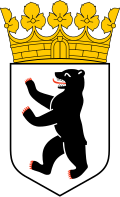Prior to 17th century
| History of Berlin |
|---|
 |
| Margraviate of Brandenburg (1157–1806) |
| Kingdom of Prussia (1701–1918) |
| German Empire (1871–1918) |
| Free State of Prussia (1918–1947) |
| Weimar Republic (1919–1933) |
| Nazi Germany (1933–1945) |
| West Germany and East Germany (1945–1990) |
|
| Federal Republic of Germany (1990–present) |
| See also |
- 1163 – Berlin founded by Albert the Bear (approximate date). [1]
- 1183 – Oak beam, discovered in 2008 by archaeologists, dated to 1183.
- 1200 – Saint Peter's Church built in Cölln (approximate date).
- 1220 – Population: 2,400.
- 1230
- St. Nicholas' Church built (approximate date).
- Tabor Church (Berlin-Hohenschönhausen) built (approximate date).
- 1237 – 28 October: First documentation of Cölln. [2]
- 1240 – Marienfelde church built (approximate date).
- 1244 – 29 April: First documentation of Berlin. [2]
- 1250
- Population: 1,200–2,000.
- Jesus Church (Berlin-Kaulsdorf) built (approximate date).
- Franziskaner-Klosterkirche built (approximate date).
- Karow (Berlin) church built (approximate date).
- 1253 – Oldest known town seal of Berlin.
- 1272 – Bakers' guild established. [3]
- 1278 – Georgenhospital established.
- 1282 – First documentation of official papers of the Margrave of Brandenburg.
- 1292 – 3 January: St. Mary's Church in existence.
- 1300 – Heinersdorf church construction begins.
- 1307
- 20 March: Legal union of Berlin and Cölln.
- Population: 4,000–7,000.
- 1360 – Berlin-Cölln joins the Hanseatic League.
- 1380 – Fire.
- 1400
- Population: 7,000–8,500.
- 1,100 buildings.
- 1432 – Merger of Berlin and Cölln.
- 1433 – Schützengilde Berlin Korp. von 1433 (militia) formed.
- 1442 – Berlin leaves the Hanseatic League.
- 1443 – Stadtschloss (palace) construction begins.
- 1446 – 7 December: Pogrom against Jews.
- 1448 – 14 October: Unsuccessful protest against the construction of the Stadtschloss. Town privileges curtailed.
- 1450 – Population: 7,000–8,000.
- 1451 – Stadtschloss built.
- 1454 – St. Erasmus Chapel consecrated.
- 1468 – First documentation of Kammergericht.
- 1484 – 18 October: Jerusalem Church in existence. [4]
- 1486 – 11 March: Berlin Stadtschloss becomes permanent seat of Brandenburg Electors.
- 1510 – 100 Jews accused of desecrating hosts. 38 burned, the rest banished and stripped of their possessions.
- 1530 – Tiergarten hunting park built.
- 1539 – 1 November: Protestant Reformation. [2]
- 1540
- Church possessions secularized.
- Printing press in operation. [5]
- 1542 – Kurfürstendamm avenue built.
- 1543 – Jagdschloss Grunewald hunting lodge built.
- 1558 – Köpenick Palace built.
- 1576
- Population: 11,000–12,000.
- Bubonic plague kills 6,000 people.
- 1594 – Spandau Citadel built.